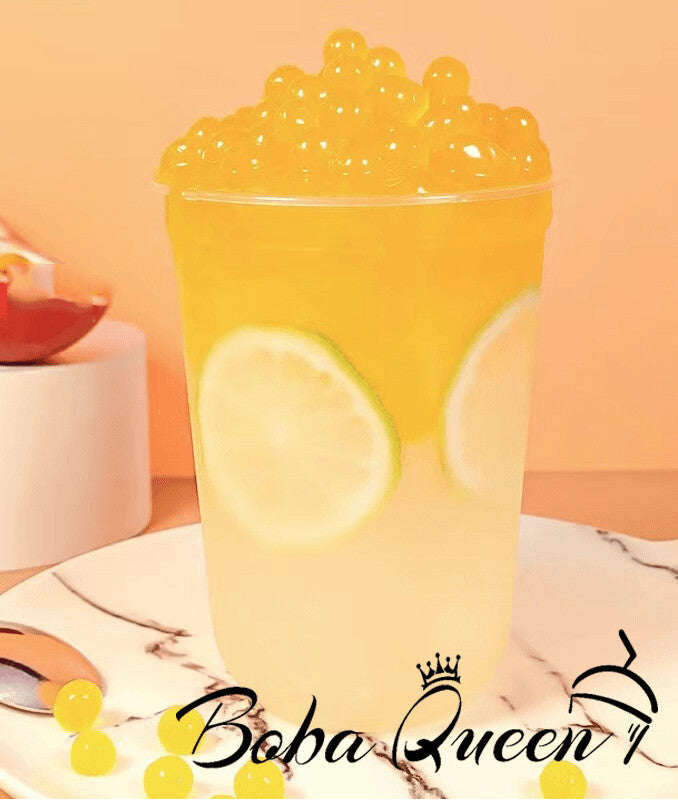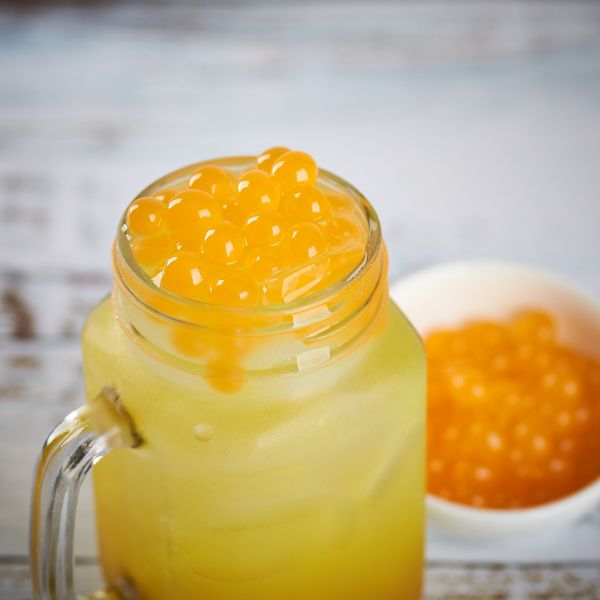Bubble tea, also known as boba tea or pearl milk tea, has become a popular drink worldwide. It originated in Taiwan in the 1980s and has since gained a cult following among tea lovers. One of the most distinctive features of bubble tea is its popping bubbles, which add a unique texture and flavor to the drink. But have you ever wondered what these bubbles are made of and how they are created? In this blog post, we will delve into the world of bubble tea bubbles and uncover their secrets.
The Surprising Chemistry of Popping Bubbles

At first glance, bubble tea bubbles may seem like simple tapioca balls or fruit jelly. However, there is actually a complex chemistry behind their creation. The main ingredient in bubble tea bubbles is tapioca starch, which comes from the cassava root. Tapioca starch is a type of carbohydrate that is commonly used in cooking and baking due to its thickening properties.
To create the iconic chewy texture of bubble tea bubbles, tapioca starch is mixed with water and then heated and kneaded until it forms a dough-like consistency. The dough is then rolled into small balls and cooked in boiling water until they become soft and translucent. These cooked tapioca balls are then soaked in a sugar syrup to give them a slightly sweet taste.
But what makes bubble tea bubbles pop? The answer lies in the process of making the tapioca balls. When the tapioca starch is heated and kneaded, it undergoes a process called gelatinization. This means that the starch molecules absorb water and swell up, creating a gel-like structure. When the tapioca balls are cooked in boiling water, the heat causes the starch molecules to expand even further, resulting in a thin outer layer and a chewy center. When you bite into a bubble tea bubble, the pressure from your teeth causes the thin outer layer to burst, releasing the chewy center and creating a satisfying popping sensation.
The Science Behind Different Bubble Sizes
You may have noticed that bubble tea bubbles come in different sizes, ranging from small pearls to large balls. The size of the bubbles is determined by the amount of tapioca starch used and the cooking process. The more tapioca starch used, the larger the bubbles will be. Additionally, the longer the tapioca balls are cooked, the larger they will become.
The size of the bubbles also affects their texture. Smaller bubbles tend to be softer and easier to chew, while larger bubbles have a more chewy and bouncy texture. Some bubble tea shops even offer customizable bubble sizes, allowing customers to choose the size of their bubbles according to their preference.
A Guide to the Different Types of Bubble Tea Bubbles

While tapioca balls are the most common type of bubble tea bubbles, there are actually many other varieties available. Here are some of the most popular types of bubble tea bubbles:
- Tapioca Balls: These are the traditional and most widely recognized type of bubble tea bubbles. They come in various sizes and can be flavored with different syrups or powders.
- Popping Boba: These are small, juice-filled balls that burst in your mouth, releasing a burst of flavor. They are often made with fruit juices and come in a variety of flavors such as mango, lychee, and strawberry.
- Jelly Cubes: These are cubes of jelly made from agar, a type of seaweed extract. They have a firmer texture compared to tapioca balls and come in a range of colors and flavors.
- Aloe Vera: Aloe vera chunks are another popular addition to bubble tea. They have a gel-like texture and add a refreshing taste to the drink.
- Egg Pudding: This type of bubble is made from a mixture of eggs, milk, and sugar. It has a creamy texture and adds a rich flavor to the drink.
Different bubble tea shops may offer different types of bubbles, so it’s always fun to try out new combinations and flavors.
Bubble Tea Bubbles Around the World
While bubble tea originated in Taiwan, it has gained popularity all over the world, leading to the creation of unique variations of bubble tea bubbles. In Japan, for example, they have mochi balls, which are made from glutinous rice flour and have a chewy and slightly sticky texture. In South Korea, they have cheese foam, which is a creamy and salty topping that adds a savory twist to the drink. In Thailand, they have grass jelly, which is made from a type of herb and has a refreshing and slightly herbal taste.
Exploring the History and Origin of Bubble Tea Bubbles

The origins of bubble tea can be traced back to Taiwan in the 1980s. The drink was invented by Liu Han-Chieh, the owner of Chun Shui Tang Teahouse, who was looking for a way to attract younger customers to his traditional teahouse. He came up with the idea of adding tapioca balls to his tea drinks, inspired by the Taiwanese dessert “fen yuan,” which also contains tapioca balls.
The original bubble tea was a simple mixture of black tea, milk, and tapioca balls. However, as the drink gained popularity, more and more variations were created, incorporating different types of tea, flavors, and toppings. Today, bubble tea is not only popular in Taiwan but also in many other countries, including the United States, Canada, Australia, and various countries in Asia and Europe.
The Controversial Origins of Bubble Tea Bubbles
While bubble tea has become a beloved drink worldwide, its origins have been a topic of controversy. Some claim that the idea of adding tapioca balls to tea drinks was actually borrowed from the Chinese dessert “tangyuan,” which also contains glutinous rice balls. Others argue that the idea of adding tapioca balls to drinks originated in Southeast Asia, where they are commonly used in desserts and beverages.
Regardless of its origins, bubble tea has become a global phenomenon, with new variations and flavors constantly being created. It has even inspired other types of bubble drinks, such as bubble coffee and bubble smoothies.
The Sensory Delight of Popping Bubbles in Bubble Tea
Aside from the unique texture and flavor that bubble tea bubbles add to the drink, they also provide a sensory experience that makes bubble tea so enjoyable. The popping sensation when you bite into a bubble, followed by the burst of flavor, is a satisfying and fun experience. This is one of the reasons why bubble tea has gained such a loyal following among people of all ages.
Moreover, the visual appeal of bubble tea bubbles cannot be ignored. The colorful and varied toppings make for an aesthetically pleasing drink, making it popular among social media users who love to share photos of their bubble tea creations.
The Role of Bubble Tea Bubbles in Culture
Bubble tea has not only become a popular drink but also a cultural icon. In many countries, bubble tea shops have become trendy hangout spots for young people, and bubble tea has even been featured in movies, TV shows, and music videos. In Taiwan, there is even a museum dedicated to bubble tea, showcasing its history and evolution.
In addition, bubble tea has also become a symbol of Asian culture, representing the fusion of traditional and modern influences. Its popularity has also led to the creation of bubble tea festivals and competitions, further cementing its place in popular culture.
The Art of Making the Perfect Bubble Tea Bubbles
Creating the perfect bubble tea bubbles requires skill and precision. While the process may seem simple, there are many factors that can affect the texture and flavor of the bubbles. Here are some key elements to consider when making bubble tea bubbles:
- Quality of tapioca starch: The quality of the tapioca starch used can greatly affect the texture and taste of the bubbles. Higher quality starch will result in smoother and chewier bubbles.
- Cooking time: As mentioned earlier, the cooking time can determine the size and texture of the bubbles. Overcooking can result in mushy or disintegrated bubbles, while undercooking can result in hard and uncooked centers.
- Sugar syrup: The sugar syrup used to soak the cooked tapioca balls can also impact the flavor of the bubbles. Some shops may use different types of syrups or add additional flavors to enhance the taste.
- Consistency: Achieving a consistent texture for the bubbles is crucial. This requires careful measurement of ingredients and precise cooking times.
- Storage: Bubble tea bubbles should be stored properly to maintain their texture and freshness. They should be kept in a sealed container with some sugar syrup to prevent them from drying out.
With these factors in mind, creating the perfect bubble tea bubbles can be a challenging but rewarding process.
The Role of Technology in Bubble Tea Bubble Production
As bubble tea continues to gain popularity, the demand for bubble tea bubbles has also increased. To meet this demand, technology has played a significant role in streamlining the production process. Machines have been developed to automate the kneading and shaping of the tapioca dough, resulting in more consistent and efficient production.
Moreover, new techniques have been developed to create unique bubble textures and flavors. For example, some shops use liquid nitrogen to freeze the tapioca balls, resulting in a crunchy and icy texture. Others use molecular gastronomy techniques to create bubbles that burst with different flavors and colors.
The Truth About the Ingredients in Bubble Tea Bubbles
While bubble tea bubbles are undeniably delicious, there have been concerns about the ingredients used to make them. The main ingredient, tapioca starch, is generally considered safe for consumption. However, some bubble tea shops may use additives or preservatives in their bubbles, which can be harmful if consumed in large quantities.
Moreover, the sugar content of bubble tea bubbles should also be taken into consideration. Tapioca balls are typically soaked in a sugar syrup, and additional syrups or powders may be added to flavor the bubbles. This can significantly increase the calorie and sugar intake of the drink, making it less healthy.
Healthier Alternatives to Bubble Tea Bubbles
For those who want to enjoy bubble tea without the added sugar and calories, there are healthier alternatives available. Some shops offer sugar-free options or allow customers to adjust the sweetness level of their drinks. Additionally, you can also opt for alternative toppings such as aloe vera or grass jelly, which have lower sugar content compared to tapioca balls.
Debunking Common Myths About Bubble Tea Bubbles
As with any popular food or drink, there are bound to be myths and misconceptions surrounding bubble tea bubbles. Here are some common myths about bubble tea bubbles and the truth behind them:
- Myth: Bubble tea bubbles are made from fish eyes.
- Truth: This myth likely originated from the appearance of tapioca balls, which may resemble fish eyes to some people. However, tapioca balls are made from tapioca starch and do not contain any fish or animal products.
- Myth: Bubble tea bubbles are high in calories and unhealthy.
- Truth: While bubble tea bubbles do contain sugar and calories, they are not inherently unhealthy. As mentioned earlier, there are healthier alternatives available, and moderation is key when consuming bubble tea.
- Myth: Bubble tea bubbles are difficult to digest.
- Truth: There is no scientific evidence to support this claim. Tapioca starch is a type of carbohydrate that is easily digestible, and the bubbles are small enough to be chewed and swallowed without any issues.
The Future of Popping Bubbles in Bubble Tea
As bubble tea continues to gain popularity, it’s safe to say that bubble tea bubbles will remain an essential element of the drink. However, with the rise of health-conscious consumers, we may see more variations and healthier options for bubble tea bubbles in the future. Some shops have already started offering alternative toppings such as chia seeds and fruit slices, catering to those who want a healthier option.
Moreover, technology will likely continue to play a role in the production of bubble tea bubbles, resulting in more creative and unique textures and flavors. We may even see the introduction of new types of bubbles that we haven’t seen before.
Bubble Tea Bubbles: A Comprehensive Guide
In this blog post, we have explored the world of bubble tea bubbles, from their surprising chemistry to their cultural significance. We have also debunked common myths and provided insights into the art of making the perfect bubble tea bubbles. As bubble tea continues to evolve and gain popularity, we can expect to see more innovations and variations of bubble tea bubbles in the future.
Conclusion
Bubble tea bubbles may seem like a simple addition to the popular drink, but there is actually a fascinating science and history behind them. From their origins in Taiwan to their global popularity, bubble tea bubbles have become an integral part of popular culture. Whether you prefer traditional tapioca balls or experimental popping boba, one thing is for sure – bubble tea bubbles will continue to delight our taste buds and add a unique experience to our favorite drink.


 Juice Concentrate
Juice Concentrate Vegetable juice
Vegetable juice Juice Milk
Juice Milk Stand Up Pouches
Stand Up Pouches









